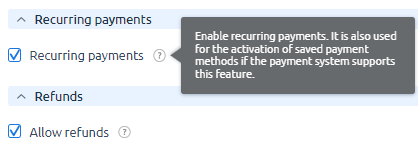Subscriptions are one of the methods of service provision. The client subscribes to the service, and money for using this service is automatically deducted from the customer at specified intervals. The client links a particular payment method for these deductions. It can be a bank card or an e-wallet.
Payment methods can be saved in BILLmanager to be later used for:
- buying new services;
- auto-renewal of existing services.
For example, the client has saved the bank card details. For payments with the same card, entering its details or confirmation of payment will no longer be required.
Subscription in BILLmanager means auto-renewal of the service using a saved payment method.
How to configure subscriptions
Configure payment methods that support recurring payments to enable customers to save the payment method and use it for subscriptions.
Recurring payments are automatic deductions of funds, which occur at set intervals.They do not require re-entering of bank card or e-wallet details. In BILLmanager, recurring payments are used to create subscriptions and to automatically replenish a personal account (auto payment). For more information about auto payments, see the article Account automatic replenishment.
The following payment methods can be used for subscriptions:
- YooKassa (New protocol) — when configuring integration with this payment method, choose payment methods Bank card or YooMoney ;
- YooKassa (outdated protocol) — when configuring integration with this payment method, choose the payment method YooMoney ;
- Payment.Center — when configuring integration with this payment method, choose payment methods Bank Card ;
- Stripe — when configuring integration with this payment method, choose payment methods Bank Card .
To enable recurring payments in the settings of these payment methods, go to Provider → Payment methods → choose payment method → Edit → enable the Recurring payments option.

The option is also available at the second step of adding the new method of payment: Provider → Payment methods → Add.
After activating the option, you will see settings in the form that are unique for each payment method. Read more about each payment method in Payment gateways.
If the provider enabled recurring payments in payment methods, its clients will see the Payment methods item in their client area. For instructions to customers on how to create a subscription, see the article Payment methods.
How do subscriptions work, auto-renewal
To create a subscription, the customer must enable auto-renewal for the service.
Auto-renewal is an automatic renewal of a service after its expiration. There are following renewal mechanisms in BILLmanager:
- from the client's personal account;
- from a linked card;
- from the client's personal account.
Auto-renewal applies to services:
- on daily debit;
- non-daily debit services that have auto-renewal enabled. For example, for a month, a year, or a longer period of time.
Renewal logic
There are several scenarios in which automatic renewal of services is triggered:
- periodic renewal — renewal is performed daily, by default at 00:15 server time. Renewal applies to services in the statuses:
- Active — if services expire on the day of renewal;
- Stopped — if auto-renewal or daily debit is enabled;
Example - when the balance is replenished — when the balance is replenished, the funds are allocated to the services with auto-renewal that were not renewed due to insufficient funds. The scenario is effective for services in the Stop status with active daily debit or auto-renewal enabled.
Example
The payment form displays all possible payment methods. If the client enables auto-renewal and selects for payment:
- a payment method that supports recurring payments, then auto-renewal of service will be charged to the selected bank card.
Example - a payment methods that does not support recurring payments, then BILLmanager will activate auto-renewal for that service from the personal account.
Example
If the client has enabled auto-renewal, BILLmanager will attempt to pay for the service three days before its expiration (for domain names 60 days before and SSL certificates — 14 days before). If the payment fails, the status of the saved card will change to Disabled.
In case of unsuccessful payment, an alert will be sent to the email specified in the settings of your client area. If the card's balance was insufficient for the payment:
- Top up its balance.
- Make payment again. The card status in Payment methods will change to Enabled.
If on the next day the card has the status Enabled, BILLmanager will attempt to make the payment again.
The statuses of saved payment methods are updated only at the time of payment.
Services in the Processing status cannot be prolonged by any of the methods. Processing is considered a transitional status, within the period of which it is not recommended to perform financial operations with the service.
Platform administrator can manage auto-renewal via API . For more details, see the article Managing services by API.
Cancelling auto-renewal
The auto-renewal option is available both on the payment form and in the cart. By default, auto-renewal is enabled on the payment form. The client can cancel it:
- when ordering a service, using the Auto-renewal switch;
- when paying for a service, using the Auto-renewal switch;
- in the Products/Services section → select the service → Edit → in the Main settings section, select Auto-renewal → select Disabled. When the paid service expires, it will not be renewed.

 En
En
 Es
Es